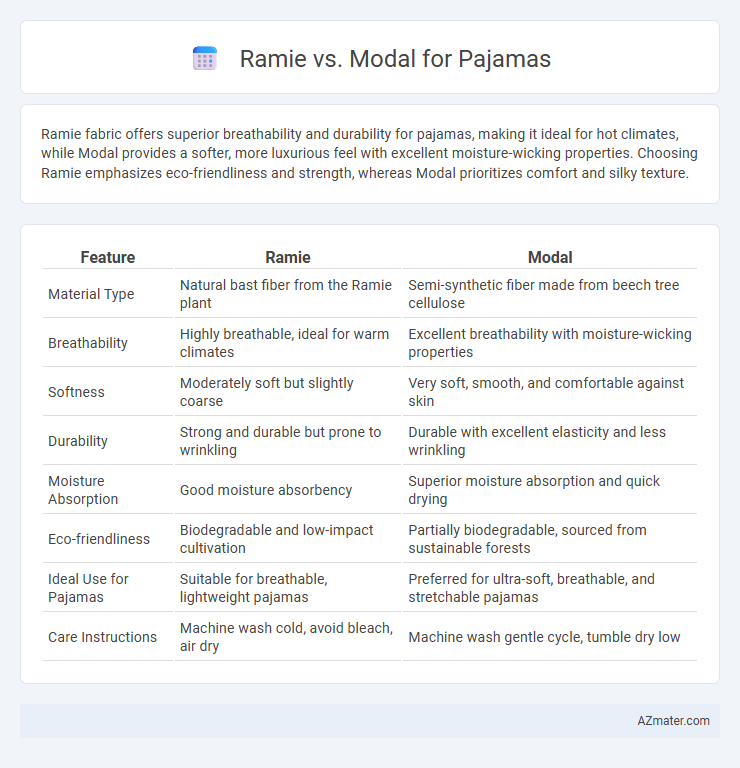Ramie fabric offers superior breathability and durability for pajamas, making it ideal for hot climates, while Modal provides a softer, more luxurious feel with excellent moisture-wicking properties. Choosing Ramie emphasizes eco-friendliness and strength, whereas Modal prioritizes comfort and silky texture.
Table of Comparison
| Feature | Ramie | Modal |
|---|---|---|
| Material Type | Natural bast fiber from the Ramie plant | Semi-synthetic fiber made from beech tree cellulose |
| Breathability | Highly breathable, ideal for warm climates | Excellent breathability with moisture-wicking properties |
| Softness | Moderately soft but slightly coarse | Very soft, smooth, and comfortable against skin |
| Durability | Strong and durable but prone to wrinkling | Durable with excellent elasticity and less wrinkling |
| Moisture Absorption | Good moisture absorbency | Superior moisture absorption and quick drying |
| Eco-friendliness | Biodegradable and low-impact cultivation | Partially biodegradable, sourced from sustainable forests |
| Ideal Use for Pajamas | Suitable for breathable, lightweight pajamas | Preferred for ultra-soft, breathable, and stretchable pajamas |
| Care Instructions | Machine wash cold, avoid bleach, air dry | Machine wash gentle cycle, tumble dry low |
Introduction to Ramie and Modal Fabrics
Ramie is a natural fiber derived from the stalks of the Chinese nettle plant, known for its strength, breathability, and moisture-wicking properties, making it ideal for comfortable pajamas in warm climates. Modal, a semi-synthetic fabric made from beech tree cellulose, offers exceptional softness, durability, and a smooth, silky feel that enhances sleepwear comfort and drape. Both fabrics are favored for pajama production due to their eco-friendly origins and excellent moisture management, but Ramie provides a crisp texture while Modal delivers a more luxurious softness.
Origins and Production Processes
Ramie is a natural fiber derived from the stalks of the Chinese nettle plant, primarily grown in China and parts of Southeast Asia, harvested through a labor-intensive process involving retting, scraping, and degumming to extract the fiber. Modal, a semi-synthetic fabric made from beech tree cellulose mainly in Europe, undergoes chemical treatment to transform the wood pulp into soft, breathable fibers. The production of ramie emphasizes eco-friendly extraction methods, while modal relies on advanced industrial techniques, impacting their texture and sustainability profiles in pajama manufacturing.
Environmental Impact Comparison
Ramie fabric, derived from the nettle family, is highly sustainable due to its low water usage and natural pest resistance, leading to minimal chemical inputs during cultivation. Modal, a semi-synthetic fiber made from beech tree pulp, is biodegradable but involves energy-intensive processing and chemical treatments that can increase environmental impact if not managed responsibly. Choosing ramie pajamas supports eco-friendly farming practices, while modal remains a softer, breathable option with moderate environmental trade-offs depending on manufacturing standards.
Comfort and Softness: Pajama-Worthy Qualities
Ramie fabric offers natural breathability and moisture-wicking properties, making it comfortable and cool for pajamas, but its texture can sometimes feel slightly coarse compared to Modal. Modal excels in softness and smoothness due to its semi-synthetic fiber origin, providing a silky touch that enhances overall comfort and is ideal for sensitive skin. The choice between Ramie and Modal for pajamas ultimately depends on prioritizing natural cooling and durability versus superior softness and a luxurious feel.
Durability and Longevity
Ramie fabric offers superior durability and longevity compared to Modal due to its strong, natural fibers resistant to wear and tear. Modal, derived from beech trees, provides a softer feel but tends to break down faster with frequent washing and prolonged use. Choosing Ramie for pajamas ensures a long-lasting garment that maintains its structural integrity over time.
Breathability and Moisture Management
Ramie fabric offers superior breathability compared to modal, making it an excellent choice for pajamas in hot and humid climates due to its natural fiber composition that promotes airflow. Modal excels in moisture management by efficiently wicking sweat away from the skin and drying quickly, enhancing comfort during sleep. Choosing between ramie and modal for pajamas depends on whether breathability or moisture-wicking performance is the priority for optimal nighttime comfort.
Care and Maintenance Requirements
Ramie pajamas require gentle hand washing with mild detergent to preserve the fabric's natural fibers and prevent stiffness, while modal pajamas offer easier care with machine washability and quick drying properties due to their synthetic cellulose composition. Ramie is prone to shrinkage and wrinkles, necessitating air drying and low-heat ironing, whereas modal resists shrinkage and maintains softness after multiple washes with minimal ironing. Choosing between ramie and modal depends on prioritizing eco-friendly natural fiber care versus convenient, low-maintenance fabric handling.
Style and Appearance Differences
Ramie pajamas showcase a natural luster and a slightly coarse texture that gives a rustic, vintage appeal, perfect for those seeking an organic, breathable fabric with a matte finish. Modal pajamas offer a smooth, silky surface with vibrant color retention and a soft drape that enhances a sleek, modern look ideal for luxurious loungewear. The difference in appearance lies in ramie's textured, matte style versus modal's polished, glossy elegance.
Price and Availability for Pajamas
Ramie pajamas generally come at a higher price point due to the labor-intensive processing of the natural fiber and limited mass production, making them less widely available in retail stores. Modal pajamas tend to be more affordable and widely accessible because the semi-synthetic fiber is easier to produce on a large scale and favored by many clothing brands. Consumers seeking budget-friendly pajama options often find modal pajamas more readily available across various online and offline platforms.
Choosing the Best Fabric: Ramie or Modal?
Ramie pajama fabric offers durability, natural breathability, and moisture-wicking properties, making it ideal for hot climates and sensitive skin. Modal excels in softness, drape, and wrinkle resistance, providing a luxurious feel with excellent moisture absorption for comfort during sleep. When choosing between ramie and modal, prioritize breathability and durability for longevity or softness and elasticity for ultimate nighttime comfort.

Infographic: Ramie vs Modal for Pajama
 azmater.com
azmater.com